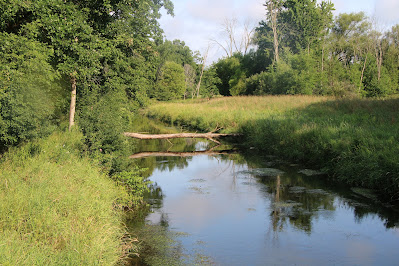With sunny skies, a refreshing midday breeze and temperatures in the upper 70’s, I’m beginning my hike on a two-track through a meadow that’s part of the Runway Disc Golf Course, just east of downtown Alma. Soon, I notice several large grasshoppers, called Carolina Locust, in flight displaying their color-banded, butterfly-like, flying wings (stock photo). Following one as it lands nearby, this 2 ½ inch insect is almost impossible to find due to its camouflage coloration. Like other locusts, it eats a variety of plants and grasses, even ones humans like, such as clover, sunflowers and corn. Up ahead, I come upon a plant, called Lamb’s Ear with spikes of pale pink flowers and fuzzy, wooly leaves, shaped like lamb’s ears. Nearby, I spot a Japanese beetle crawling on a pink blossom of Swamp Thistle and a 1-inch Yellow-collared Scape Moth perched on a Goldenrod stem. The term “scape” refers to a kind of stalk, or shaft at the base of each antenna. Other pink blossoms that catch my eye, include Common Teasel and most often-white Yarrow. Proceeding down one of the mowed fairways, I notice several Catalpa trees with their large heart-shaped leaves and foot-long seed pods, as well a very tall female, Tree of Heaven displaying clusters of red seeds. This rapidly growing deciduous tree has become a widespread invasive species across North America. Known by a number of names including stinking sumac, Chinese sumac, varnish tree and stink tree, the plant releases a strong, offensive smell, particularly from its flowers. This tree was brought from China to the United States in the late 1700s as a horticultural specimen and shade tree. Its ease of establishment, rapid growth and absence of insect or disease problems made it popular when planning urban landscaping. These same traits have led it to spread aggressively throughout the United States, crowding out native plants. The tree has also helped advance the spread of the spotted lantern fly (stock photo), an invasive insect also originally from China. These insects. feed on and damage many species of native and fruit-bearing trees. Continuing east, I finally make it to the bank of the Pine River where I pause to watch its water flow gently through a lush landscape. Along the shore, I spot a pair of perching Widow Skimmer dragonflies as well as a large Maple tree trunk gnawed by a beaver, many years ago. After stopping to explore a fawn carcass being worked on by a variety of decomposing insects, I turn around and head back toward the car.
Mother Nature
Is tuning up
Midnight howls
From a coyote pup
Babbling brook
Vireo sounds
Feeding Downy
Pecks and pounds
Cicadas' whine
Snort of a deer
Wildlife noises
Perk the ear
D. DeGraaf




